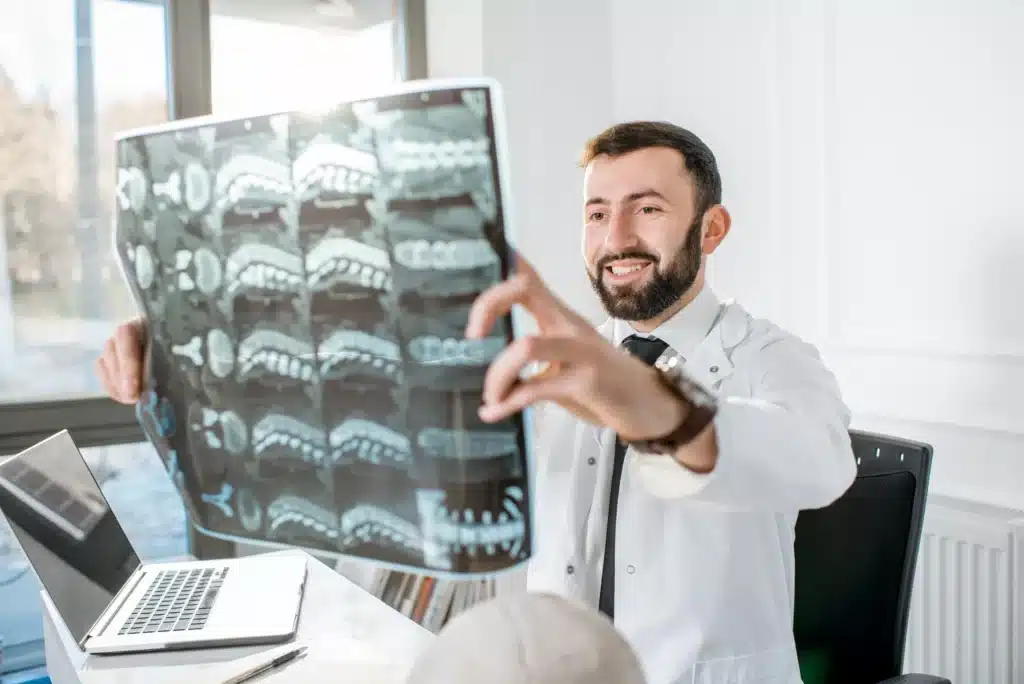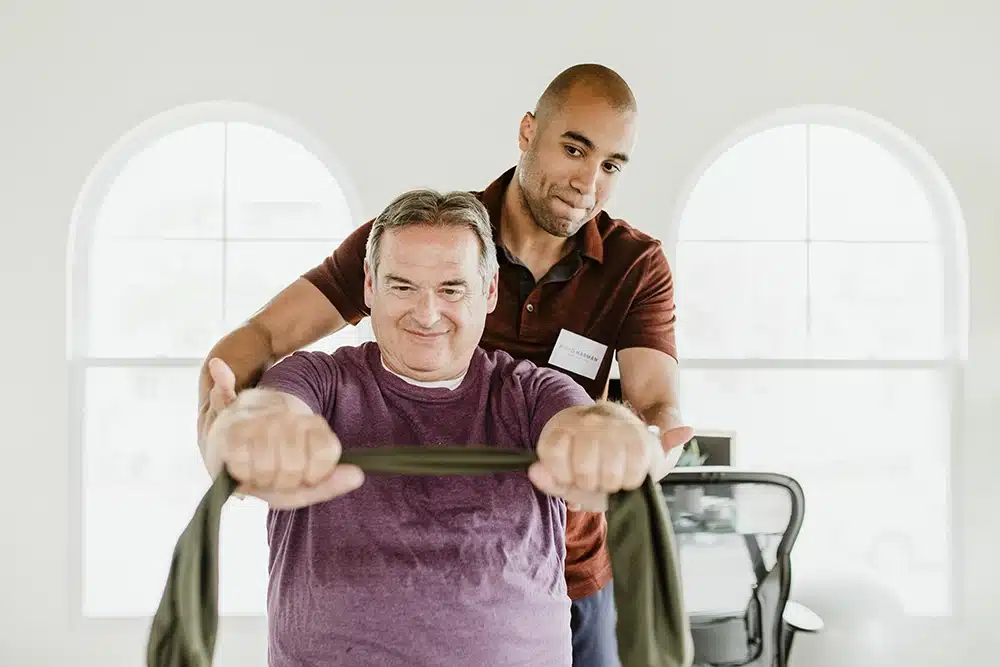
Table of Contents
ToggleSpinal fusion for scoliosis is a surgical procedure aimed at correcting the abnormal curvature of the spine seen in patients with scoliosis. This treatment involves fusing two or more vertebrae together so that they heal into a single, solid bone.
This fusion helps to prevent the progression of spinal curvature and aims to permanently correct the alignment of the spine.
In my three decades of experience as a brain and spine surgeon at Long Island Neuroscience Specialists, I’ve seen firsthand how spinal fusion can transform the lives of those suffering from severe scoliosis. It’s a procedure that requires careful consideration and thorough preparation, but one that has profound benefits for the right candidates.

Spinal fusion is more than just a surgical procedure; it’s a life-changing intervention for individuals with severe scoliosis whose spinal curves are typically greater than 45 degrees. The basic principle of the surgery is to realign and fuse the vertebrae so that they heal into a single, solid bone, effectively stabilizing the spine and preventing further curvature.
The process involves attaching metal rods, screws, or hooks to the spine to hold the vertebrae together while the bone grafts placed between them facilitate the fusion. Over my career, I’ve seen how this method not only preserves the spinal cord’s normal function but significantly enhances the patient’s quality of life by improving posture, reducing pain, and increasing mobility.
Determining who is a good candidate for spinal fusion surgery is crucial. Typically, this procedure is recommended for patients with scoliosis who have curves greater than 45 to 50 degrees, as these are likely to progress and cause further physical and cosmetic concerns.
Candidates often include adolescents whose bones are still growing and adults who experience significant pain or functional impairment due to their condition.
In our practice at Long Island Neuroscience Specialists, we take a personalized approach. Each patient undergoes a comprehensive evaluation that includes medical history, physical examination, and advanced imaging techniques to assess the severity of the curve and the spine’s overall health. This thorough assessment helps ensure that spinal fusion is not only the most suitable option but also timed perfectly to optimize outcomes.
As with any surgery, spinal fusion comes with its set of risks and potential complications. These can range from minor, such as infection at the incision site, to more severe, such as nerve damage or spinal cord injury.
However, the likelihood of serious complications is low and depends significantly on the surgeon’s skill and the facility’s quality.
At our center, we minimize these risks by using state-of-the-art surgical techniques and equipment, including robotic surgery systems that enhance precision. Furthermore, our team’s extensive experience in managing complex cases allows us to anticipate and effectively manage any issues that may arise during or after surgery.

The recovery from spinal fusion surgery is a gradual process that requires patience and careful management. Initially, patients may experience discomfort and limited mobility, but these symptoms generally improve within the first few weeks.
Recovery involves a stay in the hospital for a few days where patients receive pain management and begin basic physical therapy.
Once home, the recovery continues with more intensive physical therapy to help strengthen the back muscles and improve spinal flexibility, albeit within the safe limits of the fused spine. At Long Island Neuroscience Specialists, we provide a comprehensive post-operative care plan that includes regular follow-ups to monitor the healing process and adjust the recovery protocol as needed.
The long-term effectiveness of spinal fusion for scoliosis is impressive. Most of our patients experience a significant reduction in the degree of their spinal curvature, which remains stable over time.
The surgery not only helps in correcting spinal alignment but also in alleviating the symptoms associated with scoliosis, such as pain and respiratory issues.
Studies and patient follow-ups at our clinic have shown that spinal fusion can maintain spinal stability for years, highlighting the procedure’s durability. Moreover, patients often report improved life quality and satisfaction with their physical appearance, which underscores the procedure’s holistic benefits.

Although spinal fusion is a highly effective treatment for severe scoliosis, it is not the only option. At Long Island Neuroscience Specialists, we also discuss non-surgical alternatives with our patients, which might include bracing or physical therapy.
These methods can be effective, especially for less severe cases or for individuals who prefer a non-surgical approach.
In cases where surgery is necessary but a patient seeks a less invasive option, we might consider newer techniques such as vertebral body tethering, which allows for some correction of the curve without traditional fusion, preserving more spinal mobility.
Preparation for spinal fusion surgery involves several important steps to ensure the best outcomes. This includes pre-operative physical assessments, nutritional guidance to support healing, and psychological preparation, which is crucial given the significant nature of the surgery.
Our team at Long Island Neuroscience Specialists helps patients and their families through this process with detailed educational sessions and resources that explain what to expect before, during, and after surgery. We also assist with logistical preparations, such as scheduling and insurance authorization, to make the experience as smooth as possible.
The field of spinal surgery has seen remarkable advancements in recent years, particularly in the area of spinal fusion. Robotic-assisted surgery, which we utilize at our practice, offers unprecedented precision in placing screws and rods, significantly reducing the risk of complications.
Furthermore, the development of new biocompatible materials for bone grafts and enhancements in imaging technologies have improved the outcomes of spinal fusions, making them safer and more effective than ever before. These advancements not only improve surgical outcomes but also reduce recovery times, allowing patients to return to their daily lives quicker.
The cost of spinal fusion surgery can be a significant concern for many patients and their families. At Long Island Neuroscience Specialists, we provide a detailed breakdown of all expected costs, from pre-operative tests and the surgery itself to post-operative care and physical therapy.
We work closely with insurance providers to secure the necessary coverage and also offer guidance on navigating the complexities of insurance claims. For those who need financial assistance, we provide information on available options to ensure that financial constraints do not prevent anyone from receiving the care they need.

Sharing patient experiences is integral to understanding the real impact of spinal fusion surgery. In our practice, we’ve seen many success stories where patients have regained mobility, reduced pain, and improved their overall quality of life.
Through patient testimonials, which we often feature in our consultations, prospective patients can hear directly about the challenges and triumphs associated with their journey through spinal fusion. These stories not only provide insight into the practical outcomes but also offer encouragement and support to those considering the procedure.
The transformative effects of spinal fusion for scoliosis are profound and enduring. As a surgeon specializing in this field for over three decades, I am continually inspired by the resilience and positivity of our patients at Long Island Neuroscience Specialists. Each successful outcome reinforces our commitment to advancing spinal health and improving lives through innovative surgical care.
At Long Island Neuroscience Specialists, we believe that the surgery itself is just one part of a comprehensive treatment plan. Equally important is the ongoing education and support we provide to our patients and their families.
After spinal fusion, patients have access to a wide range of resources that include educational workshops, support groups, and continuous access to a team of specialists who are always ready to answer questions and provide guidance.
Education plays a critical role in helping patients understand their surgery and recovery process. By staying informed about the latest care techniques and what to expect during each phase of recovery, patients can actively participate in their own healing process, which often leads to better outcomes.
Our educational resources are designed to cover everything from nutritional advice to help with the fusion process, to exercises that can be done safely once the patient is ready.
The use of advanced technology in spinal fusion surgeries has been a game-changer in terms of improving accuracy and reducing risks. At our center, we utilize cutting-edge technologies such as 3D imaging and robotic-assisted surgery.
These tools allow us to plan and execute surgeries with a level of precision that was not possible a few years ago.
For example, with 3D imaging, we can create a detailed model of a patient’s spine before the surgery. This helps us to understand the complexities of each individual case and tailor our surgical approach accordingly.
Robotic-assistance, on the other hand, enhances our ability to place hardware accurately, which is crucial for the success of the spinal fusion. These technological advancements contribute significantly to reducing recovery time and improving the overall safety of the procedure.

Following spinal fusion surgery, long-term care and monitoring are essential to ensure the best possible outcome. At Long Island Neuroscience Specialists, we have a structured follow-up program that includes regular check-ups and imaging tests to monitor the health of the spine.
This ongoing care is crucial for detecting any potential issues early and addressing them before they become serious.
Our team is committed to the long-term health and well-being of our patients. We work closely with each individual to adjust their follow-up care as needed, based on their recovery progress and any new symptoms they may experience.
This personalized approach helps us ensure that each patient continues to thrive long after their surgery.
Choosing to undergo spinal fusion for scoliosis is a significant decision that can greatly improve quality of life for those with severe spinal deformities. At Long Island Neuroscience Specialists, our commitment to excellence in spinal health is driven by our desire to offer our patients the best possible outcomes.
With over 30 years of experience in the field, our team of dedicated professionals is equipped to provide expert care from diagnosis through recovery.
We understand the challenges that come with scoliosis and spinal surgery, and we are here to support our patients every step of the way. Whether it’s through offering the latest advancements in surgical techniques, providing comprehensive post-operative care, or supporting patients through their recovery journey, our goal is to help each patient achieve the best possible health and mobility.
If you or a loved one is considering spinal fusion for scoliosis, we invite you to visit our website or contact our office to learn more about how we can help. At Long Island Neuroscience Specialists, we are more than just a surgical center; we are a partner in your journey to better spinal health.
GET IN TOUCH +
285 Sills Road
Building 5-6, Suite E
East Patchogue, NY 11772
(631) 475-5511
184 N. Belle Mead Road
East Setauket, NY 11733
(631) 675-6226
GET IN TOUCH +
285 Sills Road
Building 5-6, Suite E
East Patchogue, NY 11772
(631) 475-5511
184 N. Belle Mead Road
East Setauket, NY 11733
(631) 675-6226
SUBSCRIBE TO OUR NEWSLETTER +
Send us a Google review. Click this link and let us know how we did!
Review us on Yelp too.